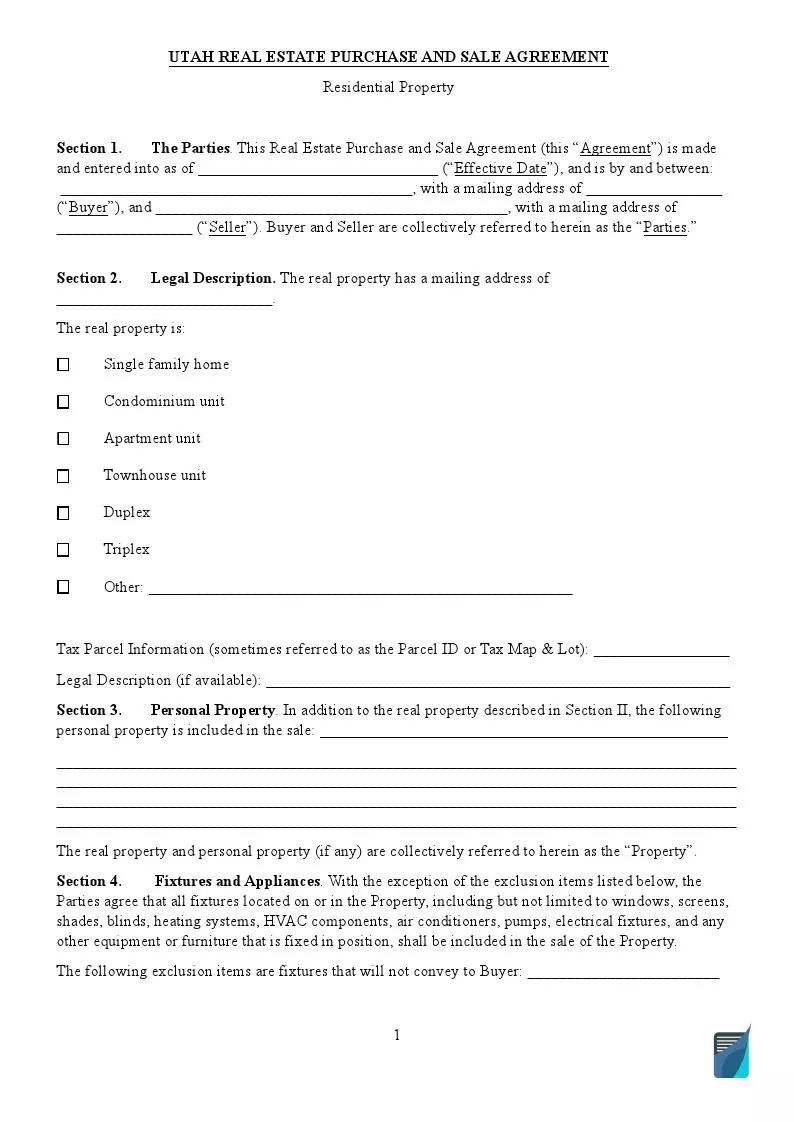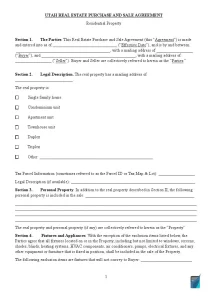Utah Real Estate Purchase Contract
The Residential purchase and sale agreement (also known as the Bill of Sale) as a legal form can be traced back to the end of the 19th century. The agreement was initially created to effect the transfer of someone’s ownership of goods while protecting the buyer’s and seller’s rights.
Generally, the printable real estate purchase agreement is a document that transfers ownership from one party to another, namely from the seller to the buyer. It is used in various cases, such as when buying goods, exchanging them, or getting a mortgage. The form is filled by a person who has an intention to purchase or sell a real estate unit. There are two parties, and the buyer typically provides the form to the seller.

Build Your Document
Answer a few simple questions to make your document in minutes
Save and Print
Save progress and finish on any device, download and print anytime
Sign and Use
Your valid, lawyer-approved document is ready
The property purchase offer must contain the following parts:
- The desirable price
- A list of all other objects in the residence that the buyer wants to own (lighting, stoves, freezers, and other equipment)
- The agreement’s closing date
- Any other additional information
As the offer expires, the seller can propose a counter-offer or accept this agreement. If all conditions are satisfactory, they sign the contract binding both parties to the deal.
The agreement is composed of only one page and is relatively easy to fill out. In addition to that, there are only a few disclosures. The realtor version comprises six pages.
Utah Commercial Purchase and Sale Agreement
Commercial property is generally regulated by Utah commercial real estate purchase and sale agreement. The commercial purchase covenant also includes various specific conditions the client uses to obtain the property and related rights.
This document specifies all the necessary conditions of the sales transaction. They can be different but should always contain the closing date and advance payment amount.
The Buyer Beware Policy
In Utah, there are no laws that require sellers to report to the buyers material defects of the premises, except when the dwelling unit has been used for the manufacture or storage of methamphetamine (§57-27-201). Nevertheless, the potential buyers should be provided with a condition report during the sales process. Licensed agents should also be allowed to advise the buyers of all possible defects.
Required Seller Disclosures in Utah
Lead-Based Paint Disclosure
This form (42 U.S. Code §4852d) is only used with buildings constructed before 1978 and is required in all the states. It contains information on whether the residence contains traces of lead paints. At that time, the paint was forbidden due to its harm to human health. The form is created to inform the new owner about the possible adverse effects. That way, if the new tenant witnesses the cracking or chipping of the paint, they should give a warning to the local authorities immediately.
The buyer can find out about the building date via the building department or the local property assessor’s office. One can also find all the needed details in the brochure called “Protect the family from lead in your home,” which gives all the essential information on possible risks along with some handy tips for newly established homeowners or tenants.
The homebuyers must be given a document called Seller’s Disclosure of Lead-Based Paint aimed to let them know that it may take place in this particular dwelling unit.
Landlords or renters who are willing to rent a building constructed before 1978 must attach the following form to the agreement Landlord’s Disclosure of Lead-Based Paint.
Lead-Paint Inspection
If one of the parties wants the inspection to be conducted, they may address the EPA’s Inspection, Risk Assessment, and Abatement Firms Locator.
- Buyer Due Diligence Checklist defines the methods used to inspect the real estate before buying it. For example, the buyer may need to complete this form as a requirement of the deal.
- Seller’s Property Condition Disclosure (R162-2f-401a) is a six-page form that contains some information on possible material defects. It is indispensable for agents.
